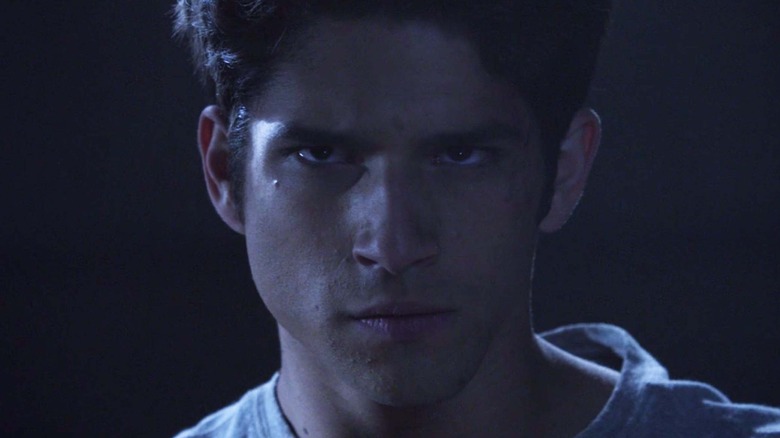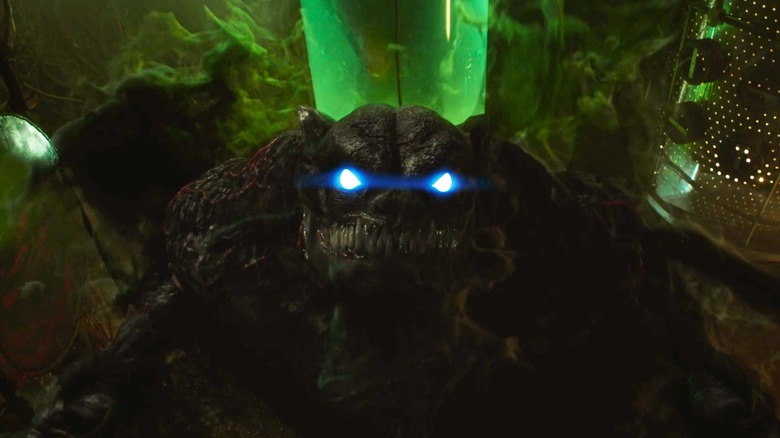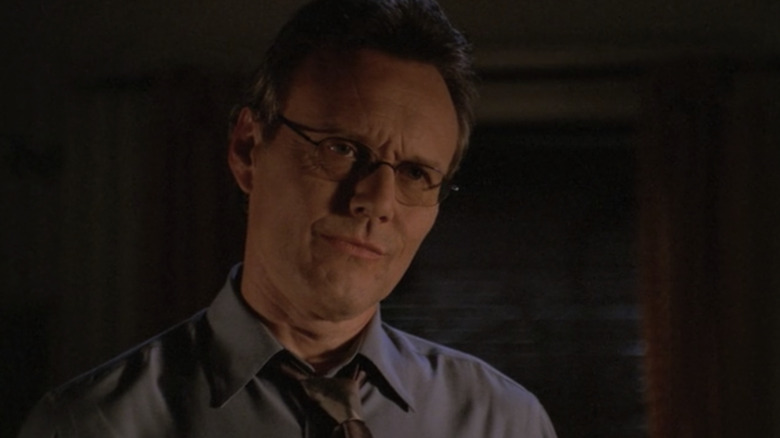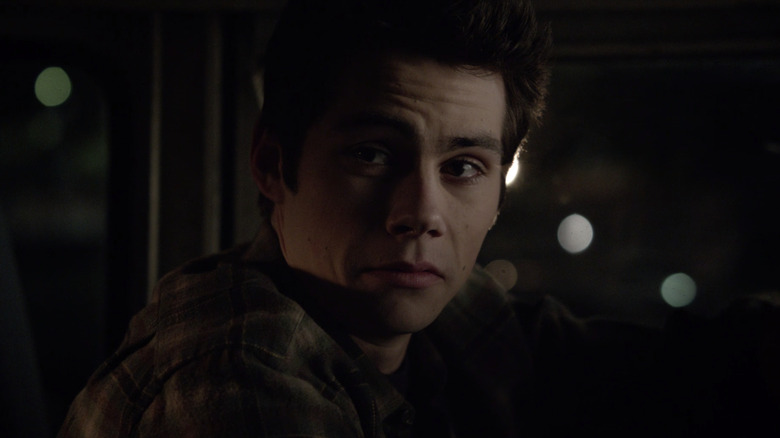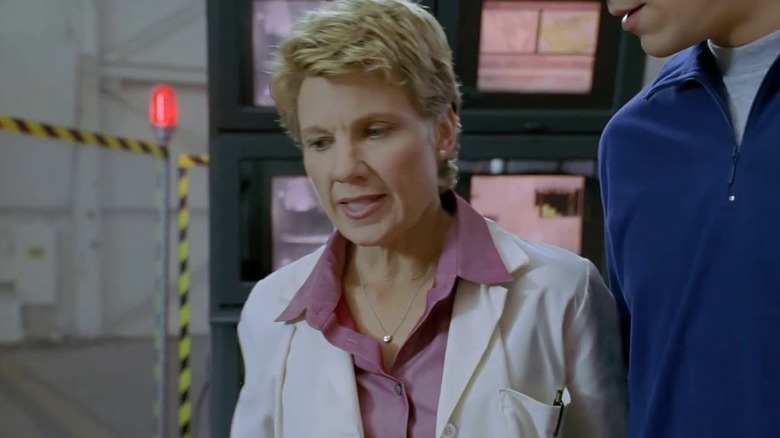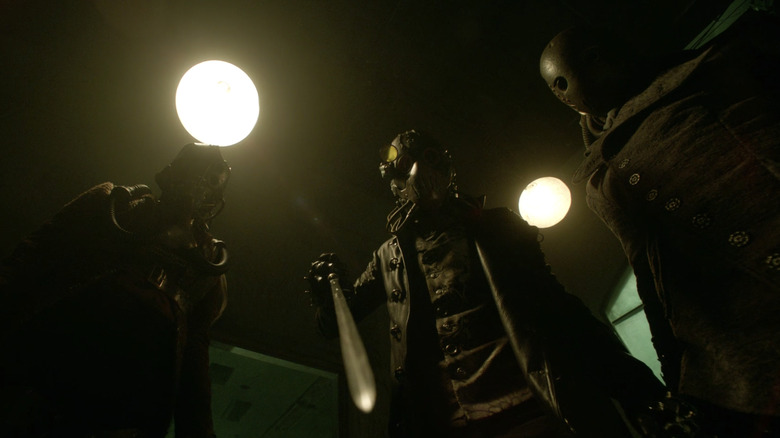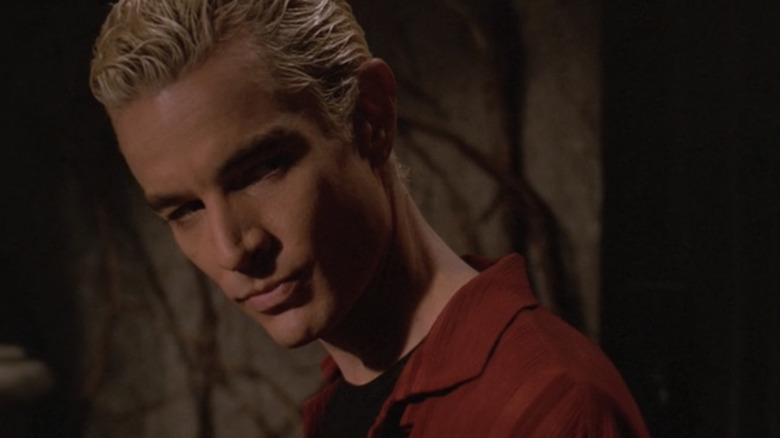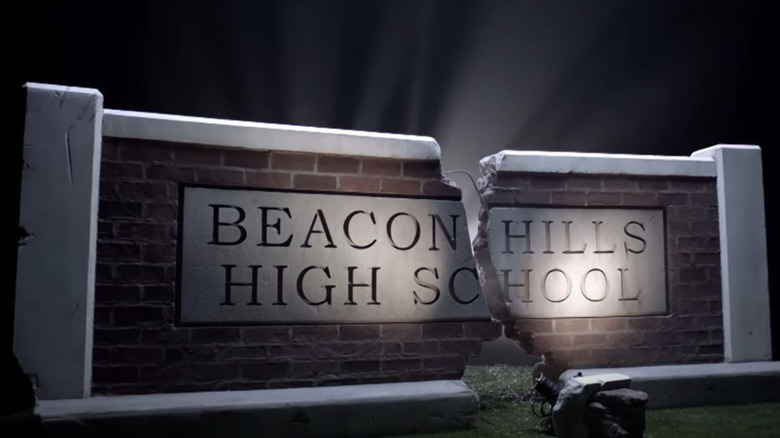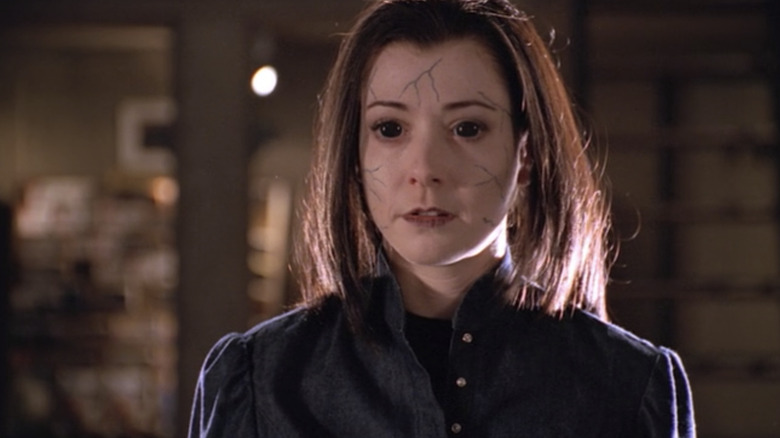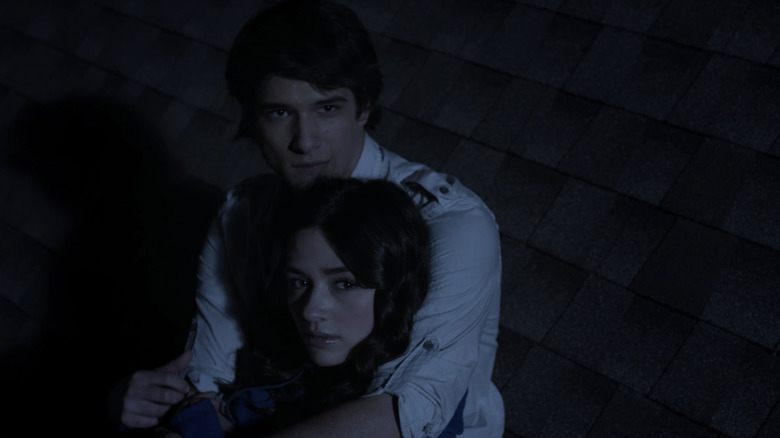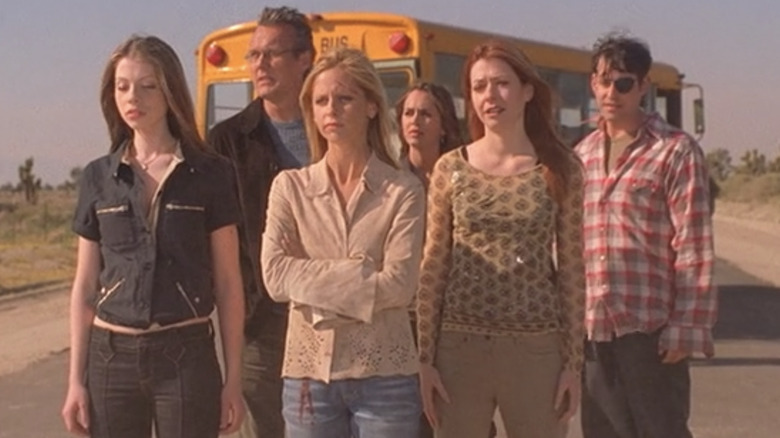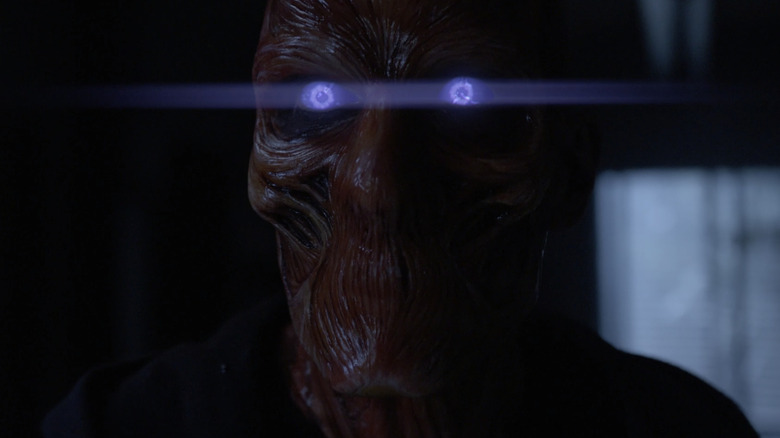How Teen Wolf And Buffy The Vampire Slayer Are Practically The Same Show
Who doesn't love a supernatural teen drama series? "Buffy the Vampire Slayer" changed television as we knew it when it premiered in the early 1990s, and it's remained a fan favorite ever since. With an extensive mythology, a quirky cast of characters, and a strong seven-year run (on two different networks), "Buffy" would make most shows jealous. There's no doubt that the series was a trailblazer for other paranormal dramas, especially the MTV original series "Teen Wolf."
Developed by "Criminal Minds" creator Jeff Davis, "Teen Wolf" follows a teenager named Scott McCall (Tyler Posey) after he suddenly becomes a werewolf and is thrown into the supernatural deep end, forced to protect his small California town. Sound vaguely familiar?
With Sarah Michelle Gellar herself joining the "Teen Wolf" universe, it's clear that these two shows are at least a little connected. The harder you look at them, the clearer it becomes that "Buffy the Vampire Slayer" and "Teen Wolf" are — in a lot of ways — kind of the same show. Here are some of the biggest ways in which Buffy Summers and Scott McCall's stories are similar, which go well beyond them sharing the same basic "supernatural high school" premise and genre setting.
A Chosen One teen tasked with saving the world
In every generation there is a Slayer, and while there aren't Slayers in "Teen Wolf," both Buffy Summers and Scott McCall are the "chosen ones" of their respective hometowns, tasked with battling evil to save their worlds from darkness. While Buffy is literally chosen by otherworldly forces (though as the series continues, she's not the only one), Scott is bitten as a ploy by Peter Hale to create his own pack. Instead, Scott fights to protect Beacon Hills and his friends, not just against the Alpha Werewolf, but against every other supernatural threat that would make its way to their once-sleepy northern Californian town. Within months, Scott becomes an Alpha himself.
Even when Buffy's no longer the only Slayer, she continues to fight for those who can't defend themselves. Both Buffy and Scott hold others to a high moral standard and choose to do the right thing even when it means discomfort or death for them. Buffy dies twice in her series, and Scott draws his last breath at least once, but they're always resurrected to fight another day. Where Buffy is the true Slayer, Scott is a True Alpha — a type of werewolf that rises in the ranks through sheer force of strength and will. No matter if you're watching "Buffy" or "Teen Wolf," it's clear who your main character is — and that they'll do whatever it takes to defeat the forces of evil.
Seasonal Big Bads and weekly apocalypses
Before "Buffy the Vampire Slayer" happened, the idea of season-long "Big Bads" was pretty much non-existent on television. Ever since, however, it's become the standard that series like "Supernatural," "Smallville," and the Arrowverse shows have all followed. "Teen Wolf" is obviously no exception, though since most of the show's seasons are broken into two halves, the Big Bad usually only sticks around for one of them. Both "Buffy" and "Teen Wolf" thrive on Big Bad arcs, as well as on the recurring threat of apocalypses that may destroy everything our characters know and love. To be fair, this is the nature of most genre shows, but "Buffy" and "Teen Wolf" seem to rely on this method of storytelling the most, especially given that series like "Supernatural" and "Smallville" use the "Big Bad" trope more loosely.
Some of the best Big Bads to come out of "Buffy" include the Master, Angelus and Spike, the Mayor, and the First Evil, while "Teen Wolf" delivers Peter Hale, the Nogitsune, the Dread Doctors, the Beast of Gévaudan, and the Wild Hunt. Each of these foes prove to be deadlier than the last and force the Scooby Gang and the McCall Pack to work smarter-not-harder to save their respective hometowns. Of course, just because someone is a Big Bad one season doesn't mean that they can't return again later on, and some of them eventually even become allies.
A mentor with secret knowledge of the supernatural
The world of the paranormal is a strange place with very specific rules and lots of loopholes to be explored. That means that it's vital for our main characters to have a wise mentor who can show them all the ins and outs. In "Buffy the Vampire Slayer," that role is filled by Rupert Giles, a member of the Watchers Council who's tasked with aiding Buffy and training her to be a better Slayer. In "Teen Wolf," the mentor role is usually filled by Scott's boss Dr. Alan Deaton, a Druid emissary meant to act as the bridge between Scott's werewolf side and humanity. But Deaton isn't alone in this mentorship role, as Derek Hale — an Alpha werewolf himself — also trains Scott in the ways of a shapeshifter.
Eventually, both Buffy and Scott outgrow their need for father-figure mentors like Giles and Deaton, with Giles eventually moving back to London — though he often returns to help Buffy — and Deaton decreasing his presence in Beacon Hills so Scott can grow. Even Derek leaves Beacon Hills in Scott's capable hands, only to show up again in the show's final hour to help his friend. Both Buffy and Scott grow into leaders of their own, with Buffy leading a new generation of Slayers, and Scott leading his own pack of werewolves — namely his Beta, Liam Dunbar, who he turns in "Teen Wolf" Season 4.
A Quirky, Non-Powered Best Friend
Every great superhero needs a sidekick, or at least an average best friend to share all their problems with. In the case of Buffy Summers, that's often Xander Harris (Nicholas Brendon), a goofy teenage boy who initially pines after the Slayer before becoming one of her closest friends. Xander is best known for his nerdy references ("kill us both, Spock"), his willingness to throw himself into danger to impress a girl, and his casual sexual innuendos. He also has a lot of heart, though, and he's always willing to die alongside Buffy if necessary. Xander gives his all to protect Sunnydale — or, at least his left eye — and he's about as loyal as they come.
In "Teen Wolf," Scott McCall's best friend Stiles Stilinski (Dylan O'Brien) is a bit more mischievous, though his heart is almost always in the right place. Stiles is the main reason Scott gets turned into a werewolf in the first place, and he sticks by his friend after, learning everything there is to know about werewolves in order to help him. Stiles remains a loyal non-human member of the McCall Pack who fights hard to protect Beacon Hills no matter the cost — which sometimes means being possessed by an evil spirit, and other times being erased from existence. If nothing else, Stiles is certainly a trooper with a great sense of humor.
An anti-supernatural task force
In the worlds of both "Teen Wolf" and "Buffy the Vampire Slayer," it's inevitable that the supernatural would eventually catch the eye of the general public, or at least some group of concerned citizens hoping to eradicate demons and werewolves from the Earth. On "Teen Wolf," this role is filled by the Hunters, and primarily by the Argent family. The Argents — their name being the French word for silver — have hunted down werewolves and other deadly shapeshifters for centuries. Even after most of the Argents are killed in battle, other Hunters rise up to fight the shapeshifters — namely an army led by Gerard Argent's second-in-command Tamora Monroe.
On "Buffy," this role looks a bit different. Instead of a group of concerned citizens who become their own militia, the Initiative is a government program sent to Sunnydale to capture, study, and incapacitate supernatural beings for military purposes. Using college students as their soldiers — including Buffy's college boyfriend Riley Finn — the Initiative kidnaps certain supernatural individuals like the vampire Spike and implants inhibitor chips into their brains to keep them from hurting humans. While it all sounds well and good on the surface, the Initiative isn't exactly the most trustworthy organization out there, and it eventually implodes because of the leadership's own arrogance.
The blend of science and the supernatural
In "Buffy," the Initiative doesn't just hunt down and study demons. The government organization also blends science and the supernatural by creating the part-robotic Adam, a biomechanical demonoid in the same vein as Frankenstein's monster. Thankfully, the "Buffy" characters ultimately defeat Adam, but the pseudo-scientific experiments don't stop there. Two seasons later, the villainous Trio bands together to kill the Slayer and make themselves rich through various schemes that include using witchcraft to creating a robotic Buffy. Even as early as Season 1, the demon Moloch possesses a computer before creating his own robotic body to fight the Slayer. Needless to say, it doesn't end well for him.
Although "Buffy" tends to mix science fiction and fantasy, there's no doubt that "Teen Wolf" takes the idea of blending the two genres a step further with the Dread Doctors. While the Hunters use modern technology to find and defeat supernatural creatures, the Dread Doctors — steampunk-looking mad scientists from another time — take supernatural creatures, mix them together into Chimeras, and make their own through non-supernatural means. This includes Theo Raeken, a recurring character in the show's final two seasons, who's a non-supernatural werewolf made through mad science rather than a wolf bite. With none of the weaknesses of a traditional shapeshifter, Theo also doesn't have all of the abilities of a natural werewolf — at least not until he discovers some much-needed empathy and growth.
From series villain to lovable hero
Something both "Teen Wolf" and "Buffy the Vampire Slayer" do incredibly well is taking a horrific murderer and turning him into a quirky, lovable hero — or at least an antihero. In "Teen Wolf," that character is Peter Hale, the original Alpha Werewolf who kills his niece, turns Scott into a werewolf, and tries to kill him on multiple occasions. Peter even returns from the dead to do it all over again before he becomes a recurring ally to the McCall Pack, especially after the revelation that the werecoyote Malia Tate is actually his daughter. By the end, Peter winds up being one of the most beloved characters on the show.
Similarly, when the vampire Spike first appears in "Buffy the Vampire Slayer," he's a heartless vampire who tries to tear the Slayer apart at the jugular. He might have the style of Billy Idol, but Spike doesn't have the same popularity in Sunnydale as the rock star. He quickly became popular with the fans, however, which led to a redemption arc for the character being written later on. It begins with an inhibitor chip and culminates in Spike reclaiming his own soul and giving his life for Buffy, who he falls in love with. Of course, he's quickly resurrected in "Angel."
Are Sunnydale and Beacon Hills the same town?
No matter how much you love "Teen Wolf" or "Buffy the Vampire Slayer," you probably wouldn't ever want to live in Beacon Hills or Sunnydale. Both shows take place in small-ish California towns that are home to plenty of monsters and see their fair share of apocalypses. Of course, there are differences between these fictitious West Coast locations, like the fact that Sunnydale has a college and that Beacon Hills has a competent sheriff's department, but that's basically it. Sure, Sunnydale may be in central California while Beacon Hills is further up in the woodlands of Northern California, but their placement along the Pacific Coast Highway doesn't matter much in the grand scheme.
In any event, both towns have a serious monster problem. Whether it's vampires or werewolves, witches or evil spirits, there's always an abundance of supernatural creatures drawn to these areas. Why? Well, besides the weather, Sunnydale is home to one of the largest Hellmouths in the world, while Beacon Hills is home to one of the world's seven Nemetons – beacons of power for supernatural creatures. As these sources of power draw more and more supernatural beings in, it's good that the casts of "Teen Wolf" and "Buffy" are always there to save their hometowns again and again. Well, except for Sunnydale, which Spike eventually wipes off the map. Whoops!
Best friends turning to the dark side
Quirky best friends and foes turned into friends are trademarks of many long-lasting sci-fi/fantasy series, but another common thread that both "Buffy" and "Teen Wolf" share is when our heroes' best friends turn into villains themselves. While there are always one-off episodes where someone's brainwashed into doing something evil (including Buffy and Scott), this isn't what we're talking about here. In "Buffy," both the ensouled vampire Angel and Buffy's other BFF Willow go "dark side," becoming the biggest villains of their respective seasons. Angel becomes the murderous vampire Angelous, while Willow is corrupted by her addiction to magic and her grief at the loss of her girlfriend Tara, turning her into a dark magic powerhouse who nearly destroys the world.
In "Teen Wolf," Scott's girlfriend Allison is corrupted by her grandfather into becoming an uber-violent Hunter. She sets her eyes on Derek Hale before Scott manages to bring her back into the light. That same season, Derek's something of a villain himself, creating his own pack without any care for who gets in the way. He also bites Allison's mother, leading to her death. By Season 3, Stiles is also manipulated and possessed by the Nogitsune, who takes on his form and terrorizes his friends. Needless to say, there are no enemies who can cut as deep as your best friends, and both "Teen Wolf" and "Buffy the Vampire Slayer" excel in milking the drama out of that fact.
The Romeo and Juliet factor
Forbidden love is one of the most common tropes in all of literature and media, but forbidden supernatural love is a whole other story — and another thing that "Buffy" and "Teen Wolf" have in common. The love story between Buffy and Angel is one for the ages: One the Slayer and the other a vampire, they were never meant to be. And yet, their relationship has become one of the most famous supernatural love stories in pop culture, long before the "Twilight" saga was ever even dreamed of. Angel isn't the only vampire Buffy gets the hots for either, as she also develops a complicated-at-best relationship with Spike.
In "Teen Wolf," Scott and Allison are the tortured Romeo and Juliet couple who just never seem to get the timing right. Obviously, Scott's a werewolf, and while that doesn't fully deter Allison, it makes things a lot more complicated once it's revealed that she hails from the Argent family of Hunters. Sadly, Scott and Allison don't get their happy ending on the show as Allison is killed in Season 3, but she still dies in Scott's arms confessing her love for him.
A future abroad
In the series finale of "Buffy the Vampire Slayer," Buffy and the crew take the fight directly to the First Evil inside the Hellmouth that lies beneath Sunnydale. While there, Spike — wearing a supercharged magical amulet — destroys the Hellmouth and the First's army from within, sacrificing himself to wipe that evil off the map. As the series ends, Buffy and those who make it out alive are forced to wonder what's left for them after their town is destroyed. Thankfully for fans left hoping for more, the so-called Season 8 "Buffy" comics show the Scoobies globetrotting across Europe to fight the forces of evil, eventually putting down roots by the Season 11 comics in San Francisco.
While "Teen Wolf" doesn't end with Beacon Hills blowing up, it does end with a Hunter army expanding globally. After Scott and his Pack fight to save their town, the Hunter leader Tamara Monroe escapes, only to expand her movement elsewhere. The series ends on a two year time-jump where the McCall Pack are last seen in Los Angeles, hoping to challenge Monroe's army across the globe. If there's one big thing the endings of "Teen Wolf" and "Buffy" have in common, it's that they show their stories are too big to stay in their respective California towns forever. In the end, both series are forced to move and grow beyond the city limits.
A final villain who encompasses all previous Big Bads
The last Big Bads to terrorize our heroes in "Teen Wolf" and "Buffy the Vampire Slayer" turn out to be mirrored images of each other. The First Evil — which plagues Sunnydale by spreading fear and running everyone out of town — takes on the form of many previous "Buffy" villains when terrorizing both Spike and Buffy, preying on their darkest secrets and desires. The Anuk-Ite does the same thing to Beacon Hills, making itself look like just about every foe that Scott and his friends had faced before while also preying on the town's anxieties to turn Beacon Hills against the McCall Pack.
In both cases, fear is the ultimate weapon, and each villain preys upon our heroes' doubts by appearing as old Big Bads. Of course, the ways these villains are ultimately defeated are a bit different. The First Evil doesn't have a body, and thus can't be killed, but its army can be defeated by sealing the Hellmouth. By contrast, the Anuk-Ite doesn't have an army of its own, but it does have a body, so it can be killed. In any event, the final hours of both "Buffy" and "Teen Wolf" are pretty similar — appropriate for two shows that are already very much alike.
